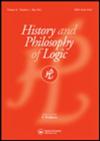Kant(37岁)有错吗
IF 0.5
3区 哲学
Q3 HISTORY & PHILOSOPHY OF SCIENCE
引用次数: 1
摘要
根据Schroeder-Heister 2018年的说法,证明论语义是“真条件语义的替代方案”。它基于这样一个基本假设:赋予我们语言的某些表达,特别是逻辑常数以意义的中心概念,是证明概念,而不是真理概念。在这个意义上,证明论语义学是在证明方面的语义学。证明论语义学也意味着证明的语义学,即描述我们如何在给定某些假设的情况下得出某些断言的实体的语义学本文主张,如上所述,证明论语义学是解决逻辑中语义问题的一种方法,这种方法在一般证明论传统(cf. Prawitz 1971)形成之前至少几个世纪就出现在主流哲学文献中。这是通过对康德1762年的论文《三段论谬误》的解释性分析来完成的,其中论证了两个论点:第一,康德在这篇文章中,在强烈的意义上,从证明的角度来探讨论证推理的逻辑有效性的问题;第二,他努力的目的是在某些不同的有效推论之间建立一个语义等价的点。本文章由计算机程序翻译,如有差异,请以英文原文为准。
Kant’s Die falsche Spitzfindigkeit and Proof-theoretic Semantics
According to Schroeder-Heister 2018, proof-theoretic semantics is ‘an alternative to truth-condition semantics. It is based on the fundamental assumption that the central notion in terms of which meanings are assigned to certain expressions of our language, in particular to logical constants, is that of proof rather than truth. In this sense proof-theoretic semantics is semantics in terms of proof. Proof-theoretic semantics also means the semantics of proofs, i.e. the semantics of entities which describe how we arrive at certain assertions given certain assumptions.' This text advocates that proof-theoretic semantics, as described above, was an approach to semantical issues in logic that appeared in mainstream philosophical literature at least a couple of centuries before the tradition of general proof theory (cf. Prawitz 1971) came into being. This is done by means of an interpretive analysis of Kant’s 1762 essay Die falsche Spitzfindigkeit der vier syllogistischen Figuren, in which two theses are argued: first, that the issue of justifying the logical validity of inferences is approached by Kant in this text, in a strong sense, in terms of proofs; and second, that the purpose of his effort is to establish a point concerning the semantical equivalence between certain distinct valid inferences.
求助全文
通过发布文献求助,成功后即可免费获取论文全文。
去求助
来源期刊

History and Philosophy of Logic
综合性期刊-科学史与科学哲学
CiteScore
0.80
自引率
0.00%
发文量
24
审稿时长
>12 weeks
期刊介绍:
History and Philosophy of Logic contains articles, notes and book reviews dealing with the history and philosophy of logic. ’Logic’ is understood to be any volume of knowledge which was regarded as logic at the time in question. ’History’ refers back to ancient times and also to work in this century; however, the Editor will not accept articles, including review articles, on very recent work on a topic. ’Philosophy’ refers to broad and general questions: specialist articles which are now classed as ’philosophical logic’ will not be published.
The Editor will consider articles on the relationship between logic and other branches of knowledge, but the component of logic must be substantial. Topics with no temporal specification are to be interpreted both historically and philosophically. Each topic includes its own metalogic where appropriate.
 求助内容:
求助内容: 应助结果提醒方式:
应助结果提醒方式:


